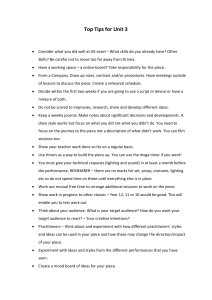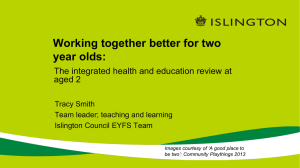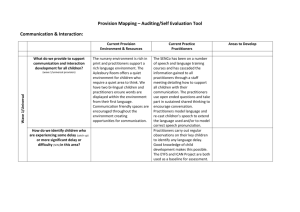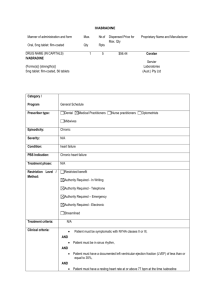DEC Score Card
advertisement
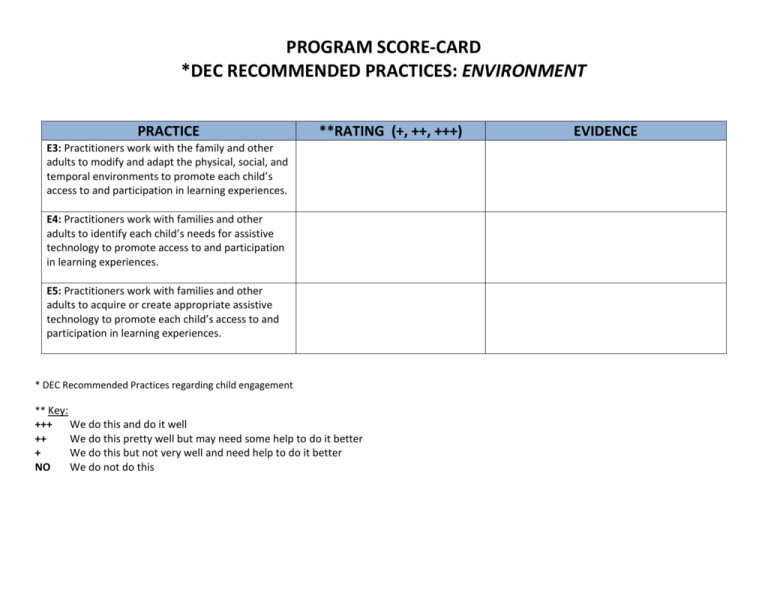
PROGRAM SCORE-CARD *DEC RECOMMENDED PRACTICES: ENVIRONMENT PRACTICE **RATING (+, ++, +++) E3: Practitioners work with the family and other adults to modify and adapt the physical, social, and temporal environments to promote each child’s access to and participation in learning experiences. E4: Practitioners work with families and other adults to identify each child’s needs for assistive technology to promote access to and participation in learning experiences. E5: Practitioners work with families and other adults to acquire or create appropriate assistive technology to promote each child’s access to and participation in learning experiences. * DEC Recommended Practices regarding child engagement ** Key: +++ ++ + NO We do this and do it well We do this pretty well but may need some help to do it better We do this but not very well and need help to do it better We do not do this EVIDENCE PROGRAM SCORE-CARD DEC RECOMMENDED PRACTICES: FAMILIES PRACTICE F1: Practitioners build trusting and respectful partnerships with the family through interactions that are sensitive and responsive to cultural, linguistic, and socio-economic diversity. F3: Practitioners are responsive to the family’s concerns, priorities, and changing life circumstances. F4: Practitioners and the family work together to create outcomes or goals, develop individualized plans, and implement practices that address the family’s priorities and concerns and the child’s strengths and needs. F5: Practitioners support family functioning, promote family confidence and competence, and strengthen family-child relationships by acting in ways that recognize and build on family strengths and capacities. F6: Practitioners engage the family in opportunities that support and strengthen parenting knowledge and skills and parenting competence and confidence in ways that are flexible, individualized, and tailored to the family’s preferences. RATING (+, ++, +++) EVIDENCE PROGRAM SCORE-CARD DEC RECOMMENDED PRACTICES: INSTRUCTION PRACTICE INS2: Practitioners, with the family, identify skills to target for instruction that help a child become adaptive, competent, socially connected, and engaged and that promote learning in natural and inclusive environments. INS3: Practitioners gather and use data to inform decisions about individualized instruction. INS4: Practitioners plan for and provide the level of support, accommodations, and adaptations needed for the child to access, participate, and learn within and across activities and routines. INS5: Practitioners embed instruction within and across routines, activities, and environments to provide contextually relevant learning opportunities. INS6: Practitioners use systematic instructional strategies with fidelity to teach skills and to promote child engagement and learning. RATING (+, ++, +++) EVIDENCE DEC Recommended Practices: Instruction (continued) PRACTICE INS7: Practitioners use explicit feedback and consequences to increase child engagement, play, and skills. INS8: Practitioners use peer-mediated intervention to teach skills and to promote child engagement and learning. INS10: Practitioners implement the frequency, intensity, and duration of instruction needed to address the child’s phase and pace of learning and/or the level of support needed by the family to achieve the child’s outcomes or goals. INS13: Practitioners use coaching or consultation strategies with primary caregivers or other adults to facilitate positive adult-child interactions and instruction intentionally designed to promote child learning and development. RATING (+, ++, +++) EVIDENCE PROGRAM SCORE-CARD DEC RECOMMENDED PRACTICES: INTERACTION PRACTICE INT1: Practitioners promote the child’s socialemotional development by observing, interpreting, and responding contingently to the range of the child’s emotional expressions. INT2: Practitioners promote the child’s social development by encouraging the child to initiate or sustain positive interactions with other children and adults during routines and activities through modeling, teaching, feedback, and/or other types of guided support. INT3: Practitioners promote the child’s communication development by observing, interpreting, responding contingently, and providing natural consequences for the child's verbal and non-verbal communication and by using language to label and expand on the child’s requests, needs, preferences, or interests. INT4: Practitioners promote the child’s cognitive development by observing, interpreting, and responding intentionally to the child's exploration, play, and social activity by joining in and expanding on the child's focus, actions, and intent. RATING (+, ++, +++) EVIDENCE INT5: Practitioners promote the child’s problem-solving behavior by observing, interpreting, and scaffolding in response to the child’s growing level of autonomy and selfregulation.


